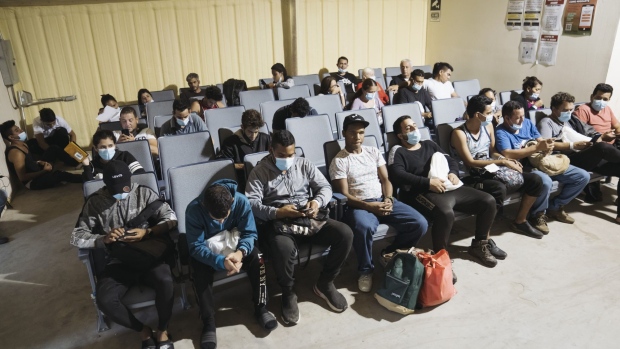May 27, 2022
Biden Bets on New Asylum Rule to Tame Chaos at Southern Border
, Bloomberg News

(Bloomberg) -- The Biden administration is counting on a rule change to speed up asylum decisions at the southern border and help ward off the turmoil expected to come if a measure that limits those claims is allowed to expire.
Department of Homeland Security officials will get the power to reject or approve asylum cases directly starting May 31. It’s a major shift from the current system that relies on the Justice Department’s immigration courts, where petitions often take years to be resolved.
Accelerating the asylum process could help officials cope with an expected crush of migrants if the Biden administration is eventually successful in its effort to end Title 42, a measure that allowed the Trump administration to practically shut down asylum claims under the stated goal of preventing the spread of Covid. A federal judge blocked the removal of Title 42 last week while a lawsuit led by a multi-state coalition of Republican attorneys general plays out.
As is, the immigration-court system is buried under a backlog of 1.8 million cases. Migrants can take advantage of that by claiming asylum to gain entry and stay in the US for months or years as the decisions drag on, said Muzaffar Chishti, the director for the New York office of the Migration Policy Institute.
“This administration is trying to remove that magnet by having these cases processed, they claim, in under six months,” Chishti said in a telephone interview. “But that’s a big change in the legal regime of asylum.”
How to deal with thousands of asylum seekers and others trying to cross the border without proper documents has stumped a string of US presidents. Some have tried to stem the flows, resulting in crammed detention centers and accusations of kids kept in cages. Loosening restrictions has only encouraged more migrants to flock to the southern border seeking entrance, according to security hawks.
The number of times the US Customs and Border Protection encountered migrants jumped to 1.7 million in the 2021 fiscal year, a 77% increase from 2019. In the first seven months of fiscal 2022, encounters surged another 73% over the same period last year and have already easily topped all of 2019.
Rule Challenges
It’s still possible the DHS rule change will be delayed or scrapped. Republican lawmakers have sought to disallow the switch. A group of GOP state officials have also filed lawsuits challenging the regulation, with Texas Attorney General Ken Paxton being the latest to seek an injunction.
The DHS declined to provide details on how many asylum cases will be processed or the expected approval rates. Some groups who advocate for asylum seekers worry the expedited process won’t allow enough time to build a solid case.
“We’re concerned about the timelines,” said Kennji Kizuka, associate director of research and analysis for refugee protection at Human Rights First. “You just can’t expect someone to put together an asylum case in a week.”
The asylum grants could spike if the approval rate matches the agency’s consent on “credible fear,” a first-step test with a lower threshold than granting asylum in which an USCIS officer determines if a person has a well-rounded fear of being harmed if returned home.
In the past 12 months, the agency approved about two-thirds of the 61,289 decisions on the credible fear tests it performed, according to data from the USCIS. In immigration courts, about 19% of those who passed the credible fear test had their asylum granted while 16% were denied during the first quarter of fiscal 2022, according to stats compiled by the immigration courts. For most of the rest, the asylum application was never filed or the case was abandoned.
“We’ll cut the backlog because they won’t be going to immigration court, but they’re all pretty much going to get asylum based on the track record of asylum officers,” said George Fishman, a senior legal fellow at the Center for Immigration Studies and the former deputy general counsel responsible for immigration under President Donald Trump.
The USCIS is authorized to have a bit more than 1,000 asylum officers and currently has 750 on staff. The agency recently trained 100 asylum officers who will begin the roll out the rule change, according to the DHS.
The program will start with people who are sent to two Texas facilities operated by Immigration and Customs Enforcement and will be limited at first to those who declare the intention of residing in Boston, Los Angeles, Miami, New York, Newark or San Francisco, according to a DHS fact sheet.
DHS Secretary Alejandro Mayorkas said the rule change is “a fair and efficient process for handling asylum claims” and that the goal is to make asylum decisions quicker, not compromise on due process.
“Individuals who qualify for asylum will receive protection more swiftly, and those who are not eligible will be promptly removed rather than remaining in the U.S. for years while their cases are pending,” Mayorkas said in a May 26 statement.
In these times of an increasingly polarized public, with immigration a top concern for many voters, the issue has become less of a problem to be solved than a political cudgel, according to Chishti of the Migration Policy Institute. It’s a particular liability for the Biden administration before November’s mid-term elections.
“This is no longer a policy dispute,” he said. “This is about politics.”
©2022 Bloomberg L.P.








